Impact Evaluation of the Community Right to Buy
An evaluation of the impact of Community Right To Buy legislation on local communities in the period from 2004 to 2014
5 Outcomes from the Community Right to Buy
OUTCOMES FOR COMMUNITIES
5.1 The following sections explore the extent to which outcomes for communities had been met and the barriers to achieving outcomes. Information in these sections is derived from the online survey of community bodies and the case study fieldwork.
5.2 The outcome areas explored in this section correspond with each outcome shown in the logic model (see Figure A). Where outcomes share similar themes, these have been grouped together and are presented under sub-headings: "awareness and engagement", "motivation and empowerment", "cohesion and pride" and "economic outcomes". Each of these themes include both short term and medium term outcomes in the logic model. Outcomes relating to land and land assets are explored separately in a later section.
5.3 As research participants were predominantly made up of representatives from community bodies, care has been taken to identify the extent to which outcomes relate to the community body members only or to the community as a whole. The distinction between the community body and the wider community was made clear in research questions (in the survey and in the qualitative research with case studies) and has been noted throughout these sections.
5.4 As well as giving an indication of the extent to which individual outcomes have been met, feedback from community bodies gives an indication of the perceived impact of the CRtB overall. Findings on the overall impact are presented first, before outcome areas are explored in turn.
Overall impact of the CRtB
5.5 Overall, 44% of survey respondents felt that the process of trying to register and buy land thought the CRtB was positive for the community body, while 22% felt it was negative and 27% said it was 'mixed' (Figure 5.1).
Figure 5.1: Positive or negative impact on the community body
Q: Overall, do you think that the process of trying to register and buy land through the Community Right to Buy has been positive or negative for the Community Body?
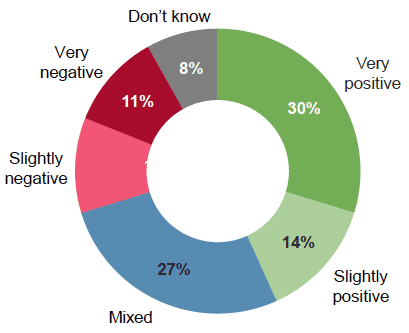
Base: All respondents giving an answer (37)
5.6 Views on the impact of the CRtB differed by the stage reached in the process. Those survey respondents that left the process at an early stage, or had attempted a purchase but were unsuccessful, were more likely to be negative. Those respondents that had successfully registered an interest or had purchased land/assets were more likely to be positive about the impact of the CRtB (Table 5.1).
Table 5.1: Impact on the community body by latest stage reached
| Latest stage reach | View on impact of CRtB on community body | |||
|---|---|---|---|---|
| % "positive" | % "mixed" | % "negative" | Base | |
| S34 (4) letter received, but did not apply to register an interest in land | 11% | 44% | 44% | 9 |
| Unsuccessful application to register an interest | 17% | 50% | 33% | 6 |
| Registration expired or deleted | 100% | 0% | 0% | 2 |
| Registration currently active | 63% | 25% | 13% | 8 |
| Land bought | 83% | 17% | 0% | 6 |
| RtB failed/rejected/CB withdrew | 67% | 0% | 33% | 3 |
5.7 Among survey respondents, views on the impact on "the community as a whole" were more positive than negative: 43% felt the process had had a positive impact on the community, 22% felt it was negative and 24% said it was "mixed" (Figure 5.2).
Figure 5.2: Positive or negative impact on the community
Q: And overall, do you think that the process of trying to register and buy land through the Community Right to Buy has been positive or negative for the community as a whole?
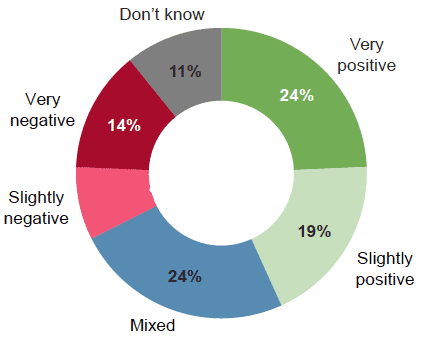
Base: All respondents giving an answer (37)
5.8 Again, views on the impact of the CRtB differed by the stage reached in the process, with those respondents that had reached the later stages more likely to be positive (Table 5.2). For example, more than half (56%) of those that had not applied to register an interest in land were negative about the impact of the CRtB, compared with none of those that had purchased land or that had registered an interest that had since expired or been deleted.
Table 5.2: Impact on the community by latest stage reached
| Latest stage reach | View on impact of CRtB on community as whole | |||
|---|---|---|---|---|
| % "positive" | % "mixed" | % "negative" | Base | |
| S34(4) letter received, but did not apply to register an interest in land | 0% | 44% | 56% | 9 |
| Unsuccessful application to register an interest | 20% | 60% | 20% | 5 |
| Registration expired or deleted | 100% | 0% | 0% | 2 |
| Registration currently active | 63% | 25% | 13% | 8 |
| Land bought | 100% | 0% | 0% | 6 |
| RtB failed/rejected/CB withdrew | 67% | 0% | 33% | 3 |
5.9 Taking views on the impact on communities and community bodies together, 43% felt that the CRtB had had a positive impact, while 22% were negative and 26% were mixed.
5.10 Among those that felt the CRtB had had a positive impact (for the community or the community body), the main reasons were that it has helped to bring the community together to form the organisation, helped to increase understanding of what the community needs, and shown that the community can take control over some aspects of its future.
5.11 Reasons for being negative about the impacts were mainly down to disappointment at being unsuccessful at acquiring the land or asset, opposition from landowners, and a sense of frustration at the process which was described as "time-consuming" and "bureaucratic".
5.12 Views about the impact of the CRtB are explored in more detail in the following sections on each outcome area.
Awareness and engagement
5.13 This section evaluates the extent to which the following short and medium term outcomes, detailed in the logic model, have been met through the CRtB process:
- Increased awareness of the Community Right to Buy
- Improved relationships between community and support agencies
- Increased awareness of support agencies.
Increased awareness of the Community Right to Buy
5.14 Awareness of the CRtB was high among survey respondents, with 80% knowing at least a fair amount about it. Thirty eight per cent of respondents stated there was at least a fair amount of knowledge about the CRtB in the community and 55% said there was a little knowledge about it (Figure 5.3).
Figure 5.3: Awareness of the CRtB
Q: How much would you say you know about the Community Right to Buy?
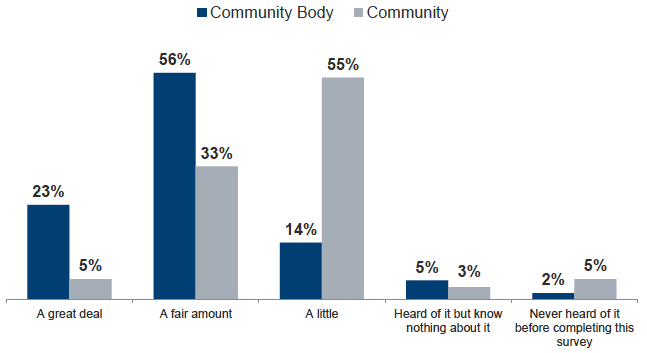
Base: All respondents giving an answer (64).
5.15 Figure 5.4 shows the number of respondents that agreed or disagreed with a statement about whether there was increased awareness of the CRtB in the local community from the CRtB application process. Most respondents (68%) agreed that awareness of the CRtB had increased in the local community.
Figure 5.4 Increased awareness of the CRtB
Q: There has been increased awareness of the CRtB in the local community?
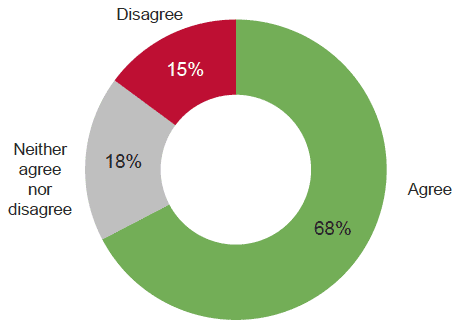
Base: All respondents giving an answer (34).
5.16 Community bodies involved in case studies were first made aware of the CRtB through a number of channels. General public discourse in the news and media was one means of hearing about the legislation. Others first gained awareness through hearing of other local communities using the CRtB to register an interest or purchase land.
5.17 After becoming aware of the CRtB, knowledge among those involved in case studies was limited initially. There was a lack of clarity on how to make an application and whether the legislation would be applicable to their community and situation. In particular, there was uncertainty about whether the CRtB was limited to certain areas e.g. the Highlands or crofting land only.
5.18 In a number of case studies, there were a select few individuals within communities who had more knowledge about the CRtB process. It was these individuals who were largely responsible for making others in the community aware of the legislation and driving the application process forward.
5.19 Community body members interviewed in the case studies felt that awareness of the CRtB increased rapidly from the time of starting the process. They felt that the process of making the application provided them with considerably more knowledge and awareness of how the legislation operated. They also felt that this awareness and knowledge extended to the wider community to a certain degree throughout the process.
Increased awareness of support agencies
5.20 Respondents had mixed views on whether the CRtB process increased knowledge and awareness of support agencies which could help the community body. As Figure 5.5 shows, less than half (43%) of respondents agreed that the process of registering an interest in land under the CRtB helped the community body learn about organisations that provide advice and guidance to local communities.
Figure 5.5: CRtB registration's impact on awareness of support organisations
Q: …To what extent would you agree or disagree that the process to register for the CRtB helped the Community Body learn about organisations that provide advice and guidance to local communities?
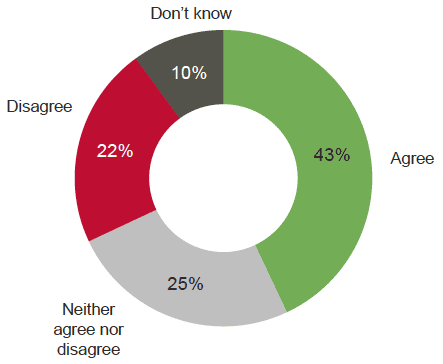
Base: All respondents giving an answer (51).
5.21 Similarly, respondents had mixed views on whether the CRtB process increased awareness of support agencies that could help the community. Only 37% agreed that the CRtB led to greater awareness of support agencies.
Figure 5.6: CRtB impact on support agencies that could help the community
Q: The CRtB has led to increased awareness of support agencies that could help the community?
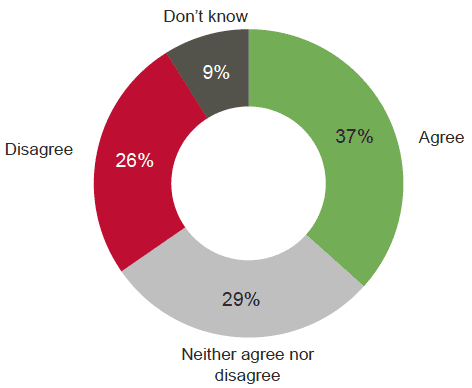
Base: All respondents giving an answer (35).
5.22 A number of participants in the case studies felt that awareness of funding and development agencies did increase throughout their CRtB process. This was particularly true for individuals closest to the CRtB process. Working with such organisations led to close relationships which were seen as beneficial to community bodies in making applications, and for communities more generally. This was true for both community bodies that made successful asset purchases, and for those who did not. Having closer ties with organisations which could fund community initiatives was viewed as a positive outcome, regardless of whether funding was achieved to make an asset purchase.
5.23 Community bodies in case studies who did not receive support from any other agencies during the application process reflected on how their application may have benefitted from assistance. One such community body felt that seeking greater legal advice may have been beneficial to their application which was not successful at the registration stage.
Improved relationships between communities and support agencies
5.24 The main source of support for community bodies when trying to register an interest in land through the CRtB was the Scottish Government who provided at least a fair amount of support to three quarters of survey respondents (Figure 5.7).
Figure 5.7: Sources of support for registering an interest
Q. How much support would you say your Community Body received, if any, from…..when trying to register an interest in land through the CRtB?
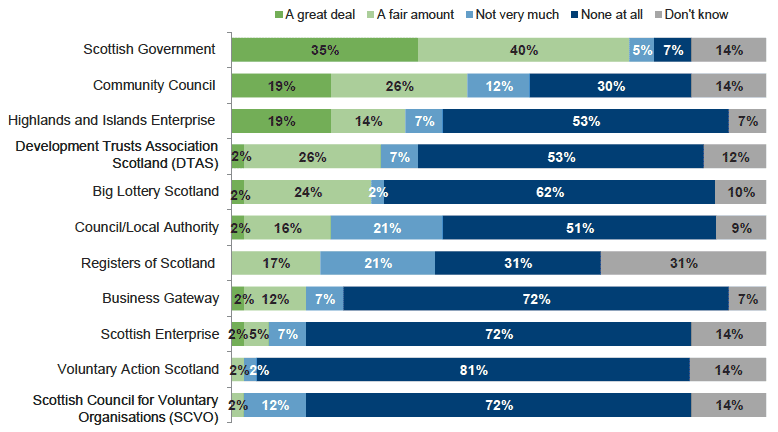
Base: All respondents giving an answer to each statement
5.25 Among those that had received support from the Scottish Government to register an interest in land, the main types of support given were advice and guidance on the application form (84%), and moral support/motivation (66%).
5.26 In general, the role the Scottish Government provided throughout the CRtB process was seen as positive by case study participants. The support and advice it offered to members in community bodies when completing the form to register an interest in land was seen as extremely valuable and helpful. Participants reflected on their good working relationship with the Scottish Government, noting that staff were approachable and quick to response to queries. One respondent referred to the role of the Scottish Government at this part of the process as:
"terrific - very helpful…Before we submitted they looked at drafts and sent things back by return post - they were very responsive."
[Case study, failed at registration]
5.27 A range of other organisations were also used by community bodies to support their applications during different stages of the CRtB process (Figure 5.7). Forty five per cent of survey respondents received at least a fair amount of support from community councils and 33% received it from the Highlands and Islands Enterprise (HIE)
5.28 Community bodies relied on these other support agencies for a number of reasons. The type of support offered by agencies would depend on which stage of the application process a community body had reached. Support agencies were used to:
- Give advice or support on making a business plan
- Provide funding to the community body during the application process
- Support events and engage the wider community, particularly at the community ballot stage
- Support the purchase of land/ asset.
5.29 Some community bodies also drew on support and advice offered by their local authority. Some relied upon their council to help with sourcing volunteers or for support in conducting the community ballot. Additionally, some community bodies drew on the advice and guidance offered by those in nearby community bodies who had also made applications to register an interest in land.
Motivation and empowerment
5.30 This section explores the extent to which communities became motivated to participate in the CRtB process or to participate in other initiatives on behalf of the community. It also examines whether or not there was an increase in knowledge and skills among communities as a result of participation in CRtB. Finally, it explores the extent to which communities have felt a sense of empowerment as a result of the CRtB.
5.31 These outcomes have been grouped together under the heading "motivation and empowerment". This group includes both short term and medium term outcomes for communities, as shown in the logic model.
Motivation to participate in the process
5.32 Among members of community bodies, the level of motivation to participate in the CRtB varied. Feedback from community bodies suggests that while those directly involved in the CRtB were motivated to take part, motivation was less apparent among members of the wider community.
5.33 Most survey respondents felt that active involvement in the community body was either increasing (48%) or staying the same (40%), while only 8% felt it was decreasing (Figure 5.8). While this indicates that motivation to participate in the community body had either increased or been sustained, it should be noted that not all community bodies were set up specifically for the CRtB and we cannot, therefore, be certain that active involvement in a community body is directly linked to motivation to participate in the CRtB.
Figure 5.8: Involvement in the community body
Q: Would you say that active involvement in the Community Body is increasing, decreasing, or staying about the same?
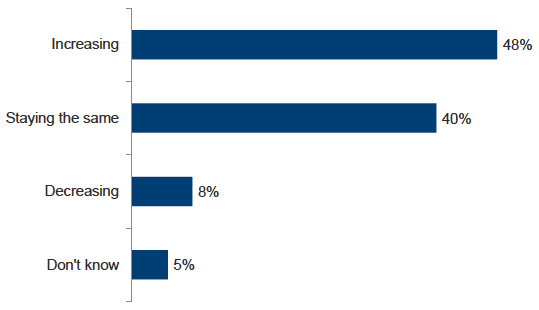
Base: All respondents giving an answer (57).
5.34 Most (89%) survey respondents felt that members of the community had supported them when they were trying to register an interest or purchase land or land asset through the CRtB (Figure 5.9).
Figure 5.9: Level of support from members of the community
Q. How much support would you say your Community Body received, if any, from members of the community when trying to register an interest in land / purchase land through the CRtB?
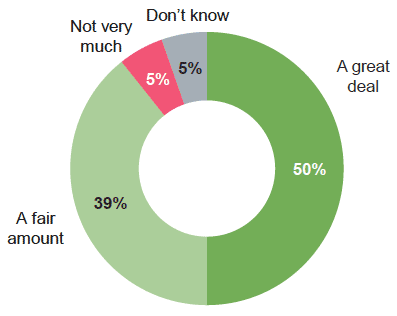
Base: All respondents giving an answer (56).
5.35 Feedback from case studies suggested that interest and support from communities was at its strongest at certain stages in the process. Firstly, during the process of submitting an application to register an interest, community members became involved as a result of awareness-raising measures carried out by community bodies (e.g. public events, newsletters, posters and flyers). Secondly, community bodies generally felt supported by the wider community when the right to buy had been triggered, particularly during the community ballot stage. However, this level of interest and support has not always been sustained. For those that have attempted to purchase an asset but have been unsuccessful (because land had not come up for sale, or because they were unable to raise funds) interest from the community decreased since the purchase fell through.
5.36 Case study feedback suggests that where successful community buy-outs have taken place, communities have become directly involved in the process by making use of the community assets that have been secured. Examples of this kind of active participation include taking part in activities organised by the community body (e.g. open days, fundraising events) and volunteering their time to help with physical activities such as painting buildings. In one case study, members of the community felt motivated to volunteer their time to support the community body as they wanted to help make the business successful, so that the wider community would benefit.
5.37 While there have been examples in case studies of communities giving their support to the community body, for the most part, motivation to participate in the process has been limited to members of the community body itself rather than the members of the wider community. This was the case even for one community body that had made a successful purchase:
"To be honest, if you stopped anyone on the street at the moment and asked about the Community Right to Buy, they won't even remember."
[Case study, successfully purchased]
5.38 In certain case studies, motivation to participate in the CRtB has been linked to key individuals involved in the community bodies. This was raised as an issue by groups located in island communities, where key individuals involved in the process had not only left the community body but also no longer lived on the islands. Where this had happened, the departure of these individuals was viewed as a barrier to sustaining the group's motivation as they had taken some of the "driving force" with them.
5.39 Where some attempted purchases had been unsuccessful, the CRtB was viewed as having had a negative impact on motivation level among members of the community. In these case studies, members of the community body described how they were left feeling "despair", at least in the immediate aftermath of a failed purchase, and ultimately "jaded" at the end of the process. These community bodies have since disbanded because the purpose of their existence, i.e. to acquire the land or land asset in question, had ceased.
"This was all done by volunteers with families and work commitments and other interests. It was initially a side project and no one expected it to take over their lives for three or four years. I think it jaded a few people - Is it worthwhile? What had we achieved…?"
[Case study, attempted purchase but unsuccessful]
Motivation to participate in other initiatives on behalf of the community
5.40 A third (34%) of survey respondents agreed that that the CRtB had led to other community initiatives being started, while the same proportion agreed that the CRtB had led to more people being involved in community activities. Almost a quarter (23%) disagreed with each of these statements (Figure 5.10).
Figure 5.10: Impact of the CRtB
Q. To what extent would you agree or disagree with each statement?

Base: All respondents giving an answer to each statement (35)
5.41 Among case studies that had successfully purchased assets, the community bodies involved had made use of the land or land assets they had acquired to deliver activities and events on behalf of the community (e.g. community open days, training courses, oral history projects).
5.42 One particular case, that had involved a successful purchase, was aiming to use the CRtB again, having seen the success of the purchase that has been made.
5.43 Among case studies that had stopped early in the process, some felt that the CRtB process had helped to put them in a position to do other things on behalf the community, as it had brought them together to form the community body. These groups had been active in other ways, such as lobbying for local issues (such as new car parking facilities or faster broadband connections) and objecting to planning proposals that they felt would be negative for the community.
"It's an active community body in various ways, not just the Right to Buy. We've done things like lobbied recently to get super-fast broadband connected and [other] things."
[Case study, attempted registration but unsuccessful]
5.44 In one case study, the community body felt that the CRtB process had helped to create a vehicle for community development, despite the land not having been acquired (it had registered an interest through the CRtB which had expired). Specific projects which had been taken forward by the community body included: development of a children's play area (funded by grants obtained by the community body); creation of a book on the history of the village illustrated with photographs obtained from the community; and management of a local community woodland owned by the Community Council. In another case, the community body initially felt stymied following a failed registration through the CRtB, but went on to identify and purchase another site (not through CRtB) that they developed into a community garden which is used by local schools, a local care home and other members of the community.
5.45 The examples of participation in activities and initiatives are, for the most, confined to members of the community bodies, rather than members of the wider community. One community body felt that, following its successful purchase of an asset, there have been several ideas from the community for uses for the site, but a shortage of people who have actually volunteered their time to help develop or deliver these ideas.
Increase in knowledge and skills from the process
5.46 The extent to which knowledge and skills have increased varied by community body. Where an increase had been observed, it tended to be more apparent within the members of the community body rather than the wider community.
5.47 Survey respondents identified a range of skills that had been improved as a result of the CRtB process (Figure 5.11) including legal knowledge (67%), knowledge about the community and its aims (61%), communication skills (57%) and organisational skills (51%).
Figure 5.11: Increase in skills and knowledge
Q: Has there been an increase in the following types of knowledge and skills among community members as a result of the Community Right to Buy process?
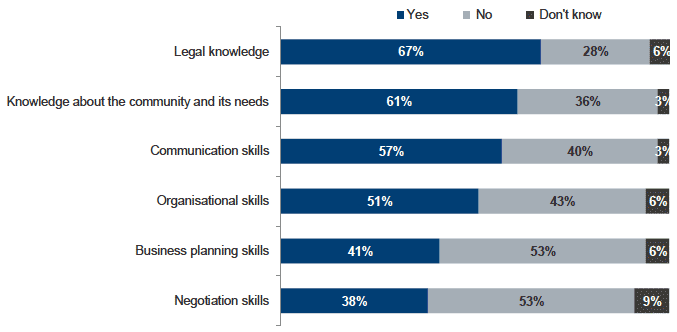
Base: All respondents giving an answer (36).
5.48 Members of community bodies that were directly involved in the CRtB cited examples of skills they had learned as a result of going through the process: increased knowledge of the legal system; understanding and interpreting legislation; writing and submitting funding applications; business planning; organising a community ballot and conducting public events. One case study participant described how the process had "stretched people" beyond what they were used to and showed members of the community body what they were capable of achieving. Another felt that going through the process had helped them learn about the range of talents and ideas that the community possessed. In general, however, the increase in skills and knowledge was mainly observed among the members of the community body that had actively participated in the CRtB process.
"In terms of skills, not for the wider community…. Within the Trust however, I think it was really good for skills development"
[Case study, successfully purchased]
5.49 Case study participants also felt that the process had helped people to learn more about their rights as a community and about the potential for community ownership of assets more generally. In one case study the community body had been unsuccessful in its attempt to purchase land or land assets through the CRtB, but its members felt that the CRtB had given them the knowledge they needed to apply for funding, conduct a feasibility study and generate community support to acquire another asset for the community.
5.50 Case studies also provided examples of community bodies learning from each other and sharing skills. One group (which was ultimately successful with their purchase) had spoken with another community group that had undertaken a community buyout to learn from their experiences. Another of the community bodies that had gone through the process, but was unsuccessful, had talked to other groups that were keen for them to share their experiences.
5.51 Other case study participants did not feel that skills and knowledge had increased, even among members of the community body. This tended to be community bodies that already had existing skills, something they considered to be a strength of their group. For example, the chair of one group that had successfully purchased an asset had previously worked in a job that involved preparing funding applications and writing business plans, therefore already had practical skills that could be applied to the CRtB process.
5.52 Some community bodies that had stopped at early stages in the process had realised, in hindsight, that their lack of knowledge and skills had been a barrier to them progressing further. In one case study that was unsuccessful at the registration stage, the community body felt that that they would have benefitted from seeking "an objective legal view" as this was expertise that they were lacking.
5.53 From stakeholders' perspectives the structure of the CRtB process (e.g. the requirement for consultation and community support) was viewed positively due to the learning opportunities it created. The requirement for the community to formulate a structured group for decision making was seen as a way of helping to build skills and social capital. Stakeholders felt that, even in cases where applications failed, communities will have benefited from the experience.
Community members feel sense of empowerment
5.54 Among survey respondents, there were mixed views on the extent to which the CRtB has helped communities to feel a sense of empowerment. This mix of views seemed to be linked to the stage reached in the process. Among case study participants and stakeholders, however, the overall view was that a sense of empowerment had been achieved.
5.55 In the survey of community bodies, 57% respondents agreed that the CRtB had made people think that they can make a real change in their community (Figure 5.12). However, this varied by stage reached in the process: all of those who had purchased assets agreed, compared with 30% of those that had attempted to purchase land or land assets but been unsuccessful and 40% of those that had not applied to register an interest in land.
Figure 5.12: Extent to which CRtB has made people think they can make real change in their community
Q: To what extent would you agree or disagree that the CRtB has made people think that they can make real change in their community ?
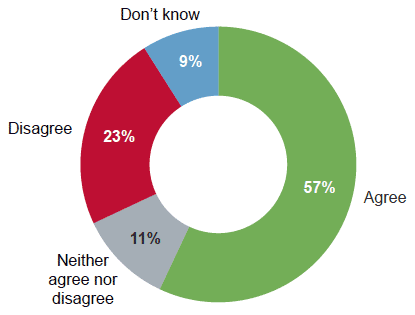
Base: All respondents giving an answer (35).
5.56 Among the 43% of survey respondents that felt the CRtB had had a positive impact overall (for the community or the community body), one of the main reasons was that it had helped to show that the community can take control of its future. These respondents tended to be those that had successfully purchased land or land assets. This was echoed in feedback from case studies that had made a purchase: participants stated the purchase has given the community a sense of achievement and a positive attitude.
"It has demonstrated that local people can take real control over some aspects of their community's affairs/wellbeing/economy."
[Survey respondent]
"Often people don't think these things can happen - [community ownership] has changed the attitude in the area, made us more positive"
[Case study, successfully purchased]
5.57 Feedback from case studies suggests that participation in the CRtB had created a sense of empowerment among communities. The sense of empowerment has not only been seen in cases where there has been a purchase. The formation of a community body was seen as an empowering step as it created a formal structure to represent the interests of the community and provided a "voice" for the community when lobbying on local issues.
'Because we are a limited company we have a bit of clout now…when you write, you do so on behalf of the board of the community company…It has given us more of a voice….or lots of voices…this has helped [when we have] objected on other things'
[Case study, successfully registered, land did not come up for sale]
5.58 The act of registering an interest, even in cases where the land was not for sale, was also viewed by case studies as a means of giving the community a voice and the ability to have more of a say in issues affecting their area. In one case study, the community body had unsuccessfully attempted a purchase but felt that the process helped them to feel that they could stand up against the landowner and that they could be proactive. They felt getting as far they did in the process (succeeding at the application stage and attempting to purchase) gave them a sense of confidence and empowerment.
5.59 Stakeholders felt that sense of empowerment was an outcome of the CRtB. They felt that one of the key outcomes from the CRtB was that it helped communities to feel that acquisition of land and assets was possible. They also thought that the legislation had legitimised community aspirations to acquire land and provided a structure for communities to utilise, while conveying the message that the state was supportive of communities having rights and opportunities to acquire assets.
Cohesion and pride
5.60 This section explores the extent to which the CRtB has led to a shared awareness and understanding of the objectives for the community, and the extent to which it has increased community cohesion. It also explores whether or not the CRtB has led to an increase sense of pride in the community.
5.61 These outcomes have been grouped together under the heading "cohesion and pride". This group includes both short term and medium term outcomes for communities, as shown in the logic model.
Shared awareness and understanding of objectives for community
5.62 Community bodies involved in case studies were clear on their objectives from the CRtB, which centred on the desire to acquire land or assets for the community, but with different areas of focus. These areas reflect the sub-themes outlined in section 4.6, namely i) desire to retain and protect and/or improve a community asset to ensure long term provision of the asset; ii) creating new greenspace and improving the community setting; iii) delivering local economic development; and iv) preventing undesirable development.
5.63 Among survey respondents, more than half agreed that the CRtB had stimulated ideas and debate on how the community could use local land and buildings differently (57%) and on what the community should be doing (53%). Further, 54% agreed that the CRtB helped the community to understand the needs of the community, while 53% agreed that the process helped deliver shared community objectives. A lower proportion (31%) felt that the CRtB overall had led to greater agreement on the shared objectives for the community (Figure 5.13).
Figure 5.13: Impact of the CRtB on shared awareness and understanding of objectives for the community
Q. To what extent would you agree or disagree with each statement?
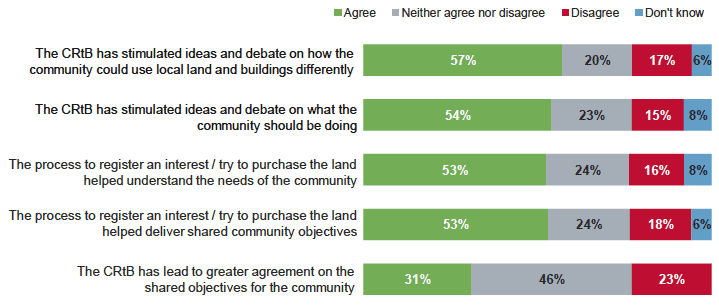
Base: All respondents giving an answer to each statement (34, 35, 39, 38, 35)
5.64 Community bodies involved in case studies described how the stages involved in the CRtB process had helped them to form an understanding of their objectives for the community, as it required them to focus on and communicate what they were trying to achieve. Applying to register an interest in land, for example, was viewed as a helpful stage as it required the community body to develop a shared vision and coherent sense of what it needed in terms of additional resources and facilities, facilitating "a sort of local village development plan." Even in cases where the asset had not come up for sale, the community body felt that the act of registering an interest had given the community a shared goal. One community body (that had successfully purchased) felt that the business planning process had also helped to focus their ideas, as it involved a series of milestones that the community body could work towards.
5.65 As was the case in other outcome areas, the extent to which the positive impact extended beyond the community body to the wider communities was mixed. As identified in relation to motivation to participate in the process, feedback from case studies suggests that communities tended to be more engaged at the stages when the group was registering an interest in land or when attempting the make a purchase. At these stages, awareness and engagement among the community was usually driven by the activities of the community body, such as public meetings, events, community votes, and information on websites and social media. Although community bodies were the driving force, some felt that their group had helped to generate a wider understanding of community objectives.
5.66 Some case study participants indicated that the community has not developed a shared understanding of its objectives. One group (that had successfully registered an interest in land) noted that the community were happy for the community body to "get on with things" and that they rarely got feedback or reaction from the public on their plans. In another case, where there was a successful purchase, a community council representative stated that the wider community were not aware of what the plans were for the asset and did not feel very involved in the activities of the community body. However, in this case, both the community body and the community council stated that they hoped to work more closely together in the future to help engage the wider community more.
Increased community cohesion
5.67 There were mixed views on this outcome. Some felt that by bringing members of the community together to meet, interact and discuss plans, the CRtB has led to a degree of community cohesion. Others felt that community cohesion was either limited, or - while it had not increased - it had not been adversely impacted by the process.
5.68 Just over half (55%) of survey respondents agreed that the CRtB (either registering an interest or trying to purchase and asset) had brought members of the community closer together (4% disagreed and 30% were neutral) (Figure 5.14).
Figure 5.14: Extent to which the CRtB has brought the community closer together
Q: To what extent would you agree or disagree that that the process to register for the CRtB / to try to purchase land brought members of the community closer together?
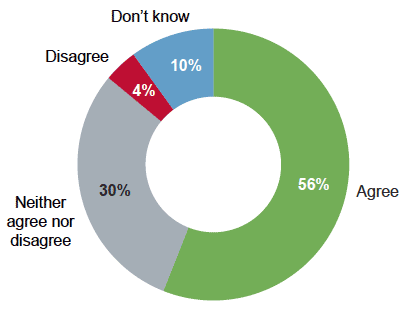
Base: All respondents giving an answer (50).
5.69 Case study participants gave examples of the CRtB providing the community with the opportunity to meet, interact and get to know each other. This was viewed as helpful in generating a "community spirit" and a shared focus for the community which was considered "unifying". A member participant felt that engaging with the community as part of the CRtB process (e.g. through public meetings, door-to-door surveying and the community ballot), and working together as a new group of people in the community body, had helped them feel more connected to their community.
"It has helped to get to know people to say 'hello' to. So that has been a positive impact from this even though we were not successful."
[Case study, attempted purchase but unsuccessful]
5.70 The community ballot was cited as an example of how the process had brought members of the community together around a common goal, particularly where there had been high turnout and a high proportion voting in favour of the CRtB buy out. One group that had successfully registered, but had not purchased, felt that the registration process itself had led to a degree of community cohesion due to the sense of focus it gives those involved.
"[The process] has requirements and deadlines and this gives a central focus, a structure and a sense of purpose which can bring people together and act as a catalyst for other things"
[Case study, successfully registered but expired]
5.71 The evidence from other case studies suggests that community cohesion had not been clearly linked to CRtB. In one case, the community body felt that community cohesion was not necessarily linked to the CRtB but to the land or land asset they had purchased. This participant felt that the community had come together as a result of a vital community resource being kept open (having previously faced closure, the alternative was that the community would have been left without the asset). They felt, however, that this sense of cohesion was not necessarily linked to the fact that the asset was in community ownership - if the asset was in private ownership the community may still have come together and made use of the resource.
5.72 In another case the community body felt that it had a lot of support during the process of purchasing the asset, however, representatives of the wider community (the community council) felt that the local residents felt removed from the process and did not feel that the purchase had made much difference to the community.
5.73 While case studies did not suggest that the CRtB had had an adverse impact on community cohesion, there have been cases where the community has felt negative about their experience. Among some of those that had been unsuccessful in the process, there was a sense of disappointment and disillusionment among members of the community, with some feeling that the process had been a "waste of time". In one case, the process of registering an interest in land created considerable tensions between the community and the landowner. In this case, the community body put plans and funding in place to purchase the land, but the landowner felt the land had been commercially devalued and refused to sell. This led to tensions on both sides, with the landowner unhappy with the level of communication about the CRtB while the community felt frustrated that the sale did not go ahead.
Increased sense of pride in community
5.74 There was limited evidence of an increased sense of pride in communities as a result of the CRtB.
5.75 In the survey of community bodies, 26% agreed that the CRtB had led to an increase in sense of pride while the same proportion disagreed (40% were neutral). Those who agreed were more likely to be those that had an active registered interest in land or had successfully purchased land (Figure 5.15).
Figure 5.15: Extent to which the CRtB has led to increased sense of pride
Q: To what extent would you agree or disagree that the CRtB has led to an increased sense of pride in the community?
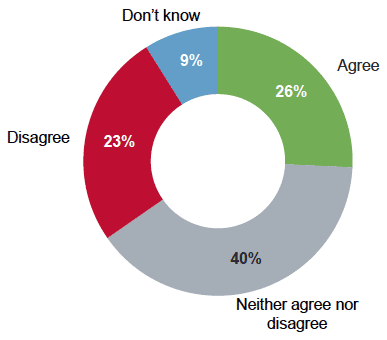
Base: All respondents giving an answer (35).
5.76 Increased sense of pride was stated as a positive outcome by a small number of case studies and survey respondents. In one case study, the community body and community members felt that the successful purchase of the asset had encouraged a sense of pride and ownership that was not there before the purchase.
"It has given people a sense of pride and ownership of this site - it is very dear to their hearts and people think of it as theirs".
[Case study, successful purchase]
"Our community feels very proud that this site is community owned - this is one the best things that has happened to our parish"
[Case study, successful purchase]
5.77 Increased sense of pride was not seen in other case studies, suggesting that this outcome had only been observed in certain cases where a successful purchase has been made but less so at earlier stages in the process.
Economic outcomes (including increased employment opportunities)
5.78 This section reviews the economic outcomes for communities and community bodies from engaging with the CRtB. Economic outcomes were strongly evident only in cases where the community had purchased/acquired the asset; this section is therefore based on a narrower set of case studies. Key economic outcomes detailed below include developing a community asset base from which to derive income streams and as a basis for development, employment creation, fostering business development and raising the profile of the area to attract inward investment. This reflects the logic model in relation to the "increased employment opportunitie" outcome, although these outcomes would be more accurately reflected by revising the outcome in the logic model to "economic development and job creation".
5.79 Survey respondents were not questioned directly on economic outcomes, but commented on the importance of having a resource for the long-term benefit of the community: "It has meant we now have a huge resource of our own that offers potential for the enhancement of our community". Positive impacts of ownership noted in responses included providing a vital service for the community, providing local economic benefit and bringing the community together.
"Kept a vital service open, but now under community control with profits being re-invested into the community through a number of different routes"
[Case study, successful purchase]
"It will for the first time give the community a significant source of unrestricted funds, allowing more ambitious projects to be developed, and hopefully the employment of a local development worker."
[Case study, successful purchase]
5.80 These views were supported by the case studies, with community bodies noting that acquiring assets with earning potential had provided the community with access to income. This included generating income from overnight tourist accommodation and generating income from room rentals to small-scale businesses, building rentals to larger businesses, and, in one case, income from grazing tenants. In the largest example, income was also generated through the provision of on-site sewerage, electricity and water supply to business tenants. In this case, a small number of large business tenants on longer leases (10-15 years) provided the community body with long term income security. A diversity of tenants on long and shorter leases (1-5 years) on the site was viewed as providing the community body with greater resilience overall (compared with only having a small number of large tenants).
5.81 In some cases, income from assets (sometimes high value assets) provided income for funding staff positions (including, in one example, a development manager) within community bodies. The protection of existing jobs and creation of further job opportunities was viewed as a critical outcome in these cases. In one case, the site purchase had resulted in safeguarding five jobs directly related to activity on the site. Employment benefits related to both direct employment within community bodies (with 10 staff employed directly by the largest case study community body) and indirect employment impacts through employment by facilities (e.g. a visitor centre) and businesses operating on the sites. In the largest example this included 160 employees of some 40 small-medium sized business tenants (including an airport and a wind turbine tower production plant) located on the site, all of whom lived in the local area. A business minded approach was viewed as key to the delivery of these outcomes, with the community body having surpassed the targets predicted in the original site business plan for income generation.
5.82 Asset acquisition had also provided a basis for future development and attracting inward investment (public and private) on these sites. Community ownership was viewed as providing opportunities to access public funding and grants (e.g. Big Lottery) to undertake refurbishment and upgrading. The largest case study for example, had engaged in a major (£1.7 million) joint agency funded infrastructural upgrading at the point of transfer. In combination with existing buildings available on the site, this has enabled the community body to provide business spaces and a well serviced site (e.g. water, power and sewage) to business tenants. Public sector involvement and support was viewed as having been critical in enabling economic outcomes, with partnership-based approaches also repeatedly noted as critical to facilitating development longer term.
5.83 The existence of a community company (with charitable status) as a central hub was also viewed as advantageous from a business development perspective, as the structure and remit of the group allowed for "the negotiation of deals which may be seen as less competitive to a private commercial operator and our independence means we can make deals quickly, which means new business units are opening up all the time". This resulted in significant and rapid outcomes, with the majority of the site's existing 40 business tenants having become established since the site was acquired by the community body.
5.84 As well as providing income to community bodies, business development (and associated employment) was recognised as resulting in increased spending in the local economy and wider community benefits. In the largest case study example, benefits included the provision of accommodation on-site, the emergence of a wider range of services available to the local community (e.g. health and fitness, a gun club, picture framers, furniture makers and others) and security around long term provision of the local airport. Community acquisition had also resulted in an upgrading of the freshwater supply to the site, which also provides 137 houses in the wider local area with their freshwater. It was noted that the full extent of wider community impact in cases where purchase had occurred was difficult to quantify accurately. Some participants in one case study also stated that impacts for community members not directly involved was limited or absent, due in part to the asset (a tourist attraction) being located outside of the village, with visitors often not stopping in the village.
5.85 Raising the profile of specific assets/sites as well as the community area more generally also represented an economic outcome in some cases, due to the associated increase in visitors. In one case, this process had included employing a marketing officer and development and implementation of a marketing strategy, specifically to publicise the site for new potential business development. A number of new business tenants had been attracted through the resulting website. As a longer term local development objective, this case study was also in the process of establishing a long term funding reserve as a "common good fund" to be used to support new business start-ups in the local area. The ambition of this specific community body (and scale of the asset) was evident from some of the long term joint-venture opportunities being explored, which included:
- Potential expansion of airport usage (by the tenant)
- A current (on going) bid to be a European Space Port, with the next round of bidding ending in 2015 and re-bidding in 2016
- Development of land based aquaculture (through development of a pipeline to the sea) on site in conjunction with regional partners
- Development of renewable energy on site, potentially including wind, solar and biomass energy, with good wind levels and forest resources available regionally, with considerable potential to sell on energy to business tenants at competitive pricing allowing energy cost stabilisation long term
- Remodelling of existing buildings on site to create a selection of smaller-scale business and office units.
OUTCOMES RELATED TO LAND / LAND ASSETS
5.86 This section reviews outcomes relating to community involvement in decision making about land and assets, including direct involvement in their management and the use of the CRtB to provide a degree of security for communities in relation to potential future use of assets. It also explores outcomes specifically relating to the use of the purchased assets, including any increased efficiency, increased utilisation and increased sustainability of land management.
5.87 This section explores the short term logic model outcome of more community involvement in the management of land and land assets and the medium term outcomes of more appropriate use and environmentally sustainable use of land and land assets, diversification of land uses and integration of land use planning.
5.88 Where outcomes relating to land and assets have been observed, this does not necessarily provide evidence that these outcomes will be sustained in the long term. Outcomes related to the use of land and land assets are considered medium term outcomes within the logic model, whereas the sustainability of these outcomes would be longer term considerations. The sustainability of outcomes related to changes in land use is, as with other long term outcomes, beyond the scope of the evaluation as they would be realised over a longer period of time and would require a longer term approach to monitoring and evaluation.
More community involvement in management of land and land assets and decisions about their use
5.89 In total, 62% of the survey respondents agreed their involvement with the CRtB had helped their community to think more about land and other assets and what they could be used for. The case studies demonstrated greater community involvement in decision making relating to the land/specific assets as a specific outcome of involvement with the CRtB. This was most evident where a purchase occurred, although some community involvement occurred at all stages of the CRtB process. In many cases, those involved were limited to a relatively small core group of community members, particularly where purchase/asset transfer had not occurred. The numbers involved and their degree of involvement increased relative to the stage of the process reached, with the highest levels of involvement on sites where a purchase had occurred and less involvement (and less continued recruitment of volunteers) in communities not having acquired an asset. On one such site, nominees for board positions had surpassed available positions at the recent AGM, with board members in this case selected to represent all localities across the community and often exhibiting strong professional skill sets.
5.90 Direct community involvement in management of land and assets occurred through contributing to steering/working groups, volunteering on specific tasks/activities, becoming elected to a community body board and being employed directly as staff. Ownership provided a high level of authority and responsibility, with one community body making redundancies after acquisition and altering the staffing structure of site staff.
5.91 A further related outcome recognised in case study communities was that a successful application to register an interest in land provided a degree of security over an asset in times of uncertainty. The process was viewed as providing communities with an opportunity to gain sufficient time to respond and organise the necessary paperwork and funding should an asset come up for sale, which would not be feasible on the timescales of the open market. In one case, a registered interest on a community building was viewed as having provided a safeguard over the (council owned) asset, due to concern that the council may have sold or demolished the facility. During the (5 year) registration period, the opportunity of local authority asset transfer emerged, which the local community has now successfully pursued, negating the need to re-register the interest:
"The application was an insurance policy, it filled a gap and protected it for that interim period, during which time the council may have sold or demolished it…so it provided a buffer until the council viewpoint changed and a new opportunity [asset transfer] emerged…we would have re-registered to maintain that security but it was no longer necessary"
[Case study, successful purchase]
5.92 This security was viewed by some as a limited form of empowerment, in that it ensured the community would be given an opportunity to acquire the asset should it go up for sale, despite the community being otherwise powerless to obtain the asset. The knowledge that a sale could not proceed without their involvement (or at least awareness) provided for some: "a big degree of comfort to know that it can't be sold to a developer or to just anyone without us at least getting a chance."
5.93 In one case, an existing CRtB application and possibility of re-registering that interest was viewed as potentially advantageous by providing potential leverage in future negotiations with the landowner. In this case the community body had the option (once the registered interest was due to expire) of suggesting not re-registering their interest on the landowners land should he be receptive to a new access agreement (or direct purchase). If the landowner were to prove unreceptive to negotiating a new agreement or a direct purchase a second CRtB registered interest offered the community body some continued long term security over the use/sale of the site.
5.94 From stakeholders' perspective, there was a view that the CRtB had facilitated a broader discussion around land use, particularly the roles and responsibilities of landowners. The CRtB was felt to have influenced landlords in relation to how they think about communities, with some approaching communities to discuss potential options related to assets transfer. It was suggested, however, that more could be done by communities to encourage involvement of landowners in the earlier stages of the CRtB process. At the stage of considering potential future uses of land/assets, the views of landowners' with first-hand experience of managing assets could be of value to the community body, For example, landowners may have carried out research to explore alternative uses for the asset; sharing this experience with community bodies may reduce the need for additional exploratory research such as feasibility studies to be carried out.
More appropriate use of land and land assets
5.95 A further related outcome evident in case studies where a purchase had occurred was the improvement of the standards of land management and the repair and refurbishment of the assets in question. This was evidenced, for example, through the reduction of costs across specific areas relative to the previous owners (e.g. fuel bills, grounds maintenance costs), despite equivalent refurbishment and improvements to assets by the community bodies. Improvements evident on these sites included a major upgrade to site infrastructure, repairs to buildings and accommodation and securing and sealing empty buildings.
5.96 Community acquisition had also resulted in increased utilisation, with higher accommodation occupancy levels (from 40% previously to 60%) evident in one of the case studies and in other case study a significant number of buildings were taken out of dereliction for use as business units.
5.97 Further, changes to active land management were evident in some cases. In one case study, the community body (although not having achieved ownership of an asset) had taken on the management of a community woodland. Since taking it on, the community trust had: commissioned a woodland management plan; cut back overhanging trees and thinned the woodland. They were also engaged in encouraging school children to use the woods and had prepared some of the area for the community to develop a community orchard.
More environmentally sustainable use of land and land assets
5.98 There was limited evidence of land or assets being used in a more environmentally sustainable way. Case studies did give examples, however, of improvements to land to make them more energy efficient and reduce fuel consumption.
More diverse use of land and land assets
5.99 Evidence of this outcome was not widespread among those that had purchased land or land asset, but there were some examples of land and assets being used in new or different ways. In the case study with the greatest number of assets, many buildings and facilities previously empty were now generating income and providing employment, evidencing a major shift in emphasis relative to the previous owners. In this case, the asset was also being used for community events and activities to specifically involve and benefit the wider community, including use of the site for a track for motorbikes, developing an assault course, shooting range and a rally. Training of local firemen, sea cadets and scout groups was also occurring. In another case study, the community owners had reduced the cost of grounds maintenance by leasing out the grounds to farm tenants. This resulted in what had been a net cost to the previous owner becoming a healthy source of income, as well as allowing the community body to build relationships with local farmers. In some cases, the primary use of the asset had remained largely similar to before the community acquired ownership, but value had been added through the delivery of activities such as volunteering opportunities, training, and community projects.
More integrated land use planning
5.100 This outcome refers to the extent to which land use had been planned in a collaborative way, involving communication and sharing of information between the community owner and any relevant parties (such as public sector bodies, support agencies, current and potential tenants, etc.). Case studies did not show evidence of this outcome, although this has reflected the feedback received from a small number of cases and does not necessarily suggest that this outcome has not happened in other cases. It can be assumed that this outcome is less likely to be evident in cases where land has a single use and where its use has been largely unchanged. Where there are multiple uses on a site, and the type of use has changed since transfer of ownership, there may be more need for an integrated or collaborative approach to planning.
LONG TERM OUTCOMES
5.101 The evaluation has identified the extent to which short term and medium term outcomes from the CRtB have been met. Long term outcomes are, by their nature, more difficult to capture as they are realised over a longer period of time and would, therefore, require more time to gather evidence than was possible within this evaluation. By following the logic model approach, however, the methodology acknowledges that evidence of short and medium term outcomes should ultimately lead to long term outcomes being achieved.
5.102 As noted earlier, the evaluation has shown the extent to which outcomes (for land and assets and for communities) have been realised in the short and medium term, but does not provide evidence that these outcomes will be sustainable in the long term. Measuring the sustainability of these outcomes would require a longer term approach to monitoring and evaluation. One of the recommendations on monitoring and evaluation of the CRtB is that further feedback is gathered from those that have made purchases on a periodic and ongoing basis (for example, every 2-3 years) to provide further evidence of long term outcomes (see section 6).
SUMMARY OF OUTCOMES
5.103 In terms of outcomes for communities, each of the short term outcomes have been met to an extent. Each of these outcomes had been met for those directly involved in community bodies. In terms of the wider community, the outcomes of "increased awareness of the CRtB", "motivation to participate in the process" and "shared awareness and understanding of objectives for the community" were evident, although the latter two were only in certain cases. The outcomes of "increased awareness of support agencies" and "increase in knowledge and skills from the process" were mostly confined to those directly involved in the process, rather than the wider community. Some outcomes were linked to particular stages in the CRtB process. For example, "shared awareness and understanding of objectives for the community" was most apparent once the right to buy had been triggered and a community ballot was being conducted. "Motivation to participate in the process" was more strongly demonstrated among cases where a successful purchase had been made.
5.104 Medium term outcomes for communities have also been met, but to varying levels. As with some short term outcomes, participants felt that outcomes such as "improved relationships with support agencies" and "motivation to participate in other initiatives on behalf of the community" were more apparent among members of the community body, than among the wider community. Mixed feedback was provided on outcomes relating to "sense of empowerment" and in relation to the outcome "community members feel a sense of empowerment", participants gave example of this being achieved at various stages of the process such as formation of a community body, registering an interest, and purchasing land or a land asset. In relation to "increased community cohesion", views were mixed. Some felt that this had been achieved through community members coming together to meet, interact and discuss plans for their future, while others felt that there had been little impact in this area. Where other outcomes have been met, these tended to be more clearly demonstrated in cases where a successful purchase had been made. This was particularly the case for "increased sense of pride in the community" and "increased employment opportunities" - these outcomes had been realised among a small number of cases, but there was little evidence of them beyond those that had purchased assets.
5.105 Short and medium term outcomes relating to land/land assets were confined to those cases where a purchase had occurred. The short term outcome of "more community involvement in management of land/land assets" had been demonstrated among those that have successfully purchased an asset. The picture was more mixed in relation to outcomes related to use of land and assets. There was evidence of land and assets being used in a more appropriate and more diverse way, but less evidence of more environmentally sustainable uses or integrated land use planning.
5.106 As noted in the section on inputs, local context has been an important driver for communities getting involved with the CRtB. As such, each community will have its own set of circumstances that may play a role in their level of success in the process and the outcomes that are realised. However, feedback from case studies has identified some common inputs (or "enablers") that have played an important role in helping to achieve outcomes.
- One of the earliest steps in the CRtB process, the formation of community bodies has been key. While not all community bodies have been formed specifically for the purpose of pursuing the CRtB, by participating in the process they have helped to provide a focal point for communities and have given communities a voice that they may not have otherwise had. Members of community bodies have spent time going through each stage of the CRtB process, including preparing application forms and liaising with support agencies, therefore it is somewhat inevitable that certain outcomes (such as increase in knowledge and skills) are more clearly linked to those directly involved than to the wider community. By raising awareness about the CRtB, organising events and conducting community ballots, community bodies have also helped to bring communities together, therefore playing a vital role in outcomes such as increased community cohesion.
- Linked to the above point, in certain cases the presence of key individuals has been an important enabler to achieving outcomes. Individuals that have been particularly active in the community body have helped motivate others to participate in the process. However, when these key individuals are no longer involved this has been viewed as somewhat of a barrier to achieving outcomes.
- Advice and guidance from support agencies have played an important role in the process. Advice from Scottish Government, in particular, has helped to develop knowledge and skills relating to the CRtB process (e.g. tips on completing applications to register an interest in land). However, a small number of participants felt there was a potential tensions between Scottish Government's role in providing advice to community bodies and its role in advising ministers on whether or not applications to register an interest in land should be supported.
- Where land/assets have been purchased, a willing seller has helped make the process easier and to make a successful purchase more likely. Where this is absent, the chance of a successful purchase is unlikely which can be demotivating for communities. Absence of a willing seller has been a major obstacle to a successful purchase and therefore prevented some outcomes associated with a purchase being achieved. Where this has been the case, not only have outcomes relating to land/assets not been achieved, it has also made outcomes relating to communities such as "sense of pride in the community" more difficult to achieve.
5.107 Acknowledging that communities will have faced their own specific challenges linked to their unique circumstances, a number of common barriers to achieving outcomes have been identified. In a number of cases, these barriers are linked to an absence of one of the key enablers outlined above.
- In certain cases, it has been difficult for community bodies to sustain interest from the community in the long term. This has been particular challenge in cases where a registration has been active for a long period (e.g. 5 years) and a re-registration of an interest in land is required.
- While the existence of community bodies has been identified as a key element in contributing to outcomes, in some areas an ageing and declining population has made it difficult to attract new members of the community body. This has made delivering activities and driving interest among the wider community a challenge for those involved.
- Lack of specialist knowledge and expertise has been identified as a hurdle for certain community bodies. The CRtB process has been described by community bodies as time consuming and arduous and the level of information required within the timescale available has presented a challenge. Some community bodies that had stopped at early stages in the process had realised, in hindsight, that their lack of knowledge and skills had been a barrier to them progressing further. The types of skills that were lacking included legal expertise, and the ability to complete some of the information required (e.g. memorandum and articles of association, and business plans).
Contact
Email: Graeme Beale
There is a problem
Thanks for your feedback